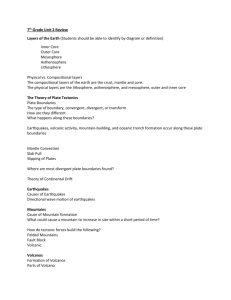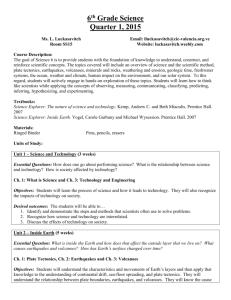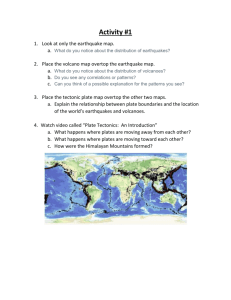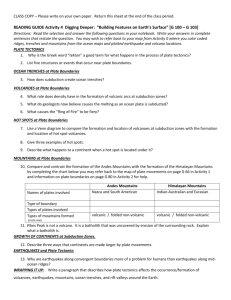Study Guide Here
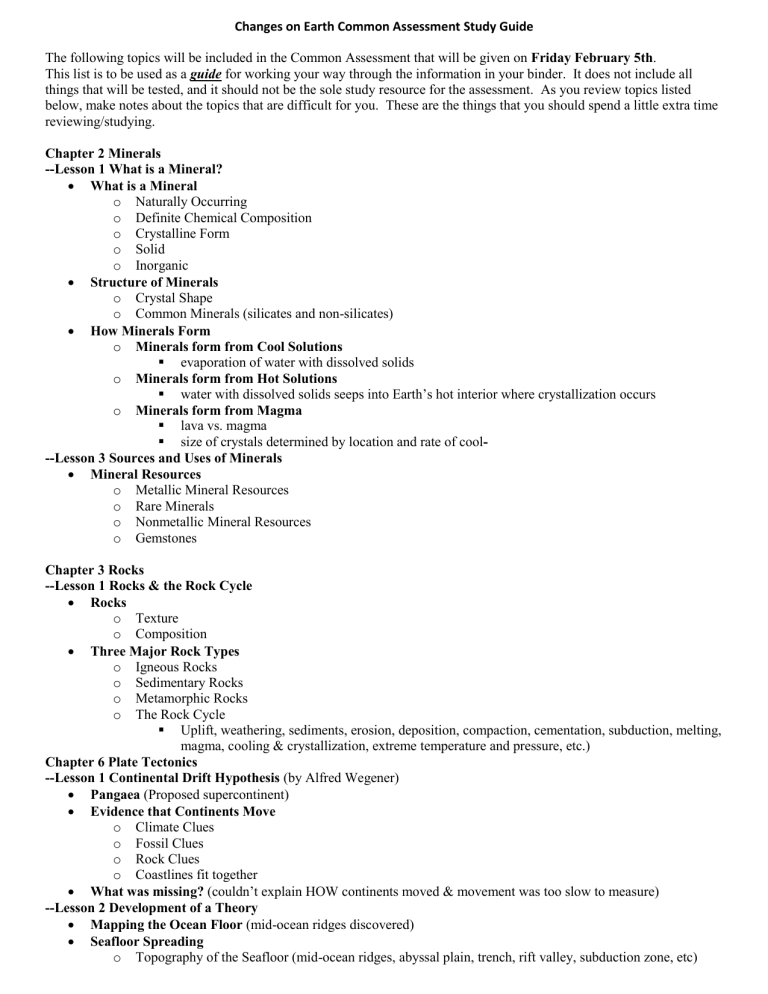
Changes on Earth Common Assessment Study Guide
The following topics will be included in the Common Assessment that will be given on Friday February 5th .
This list is to be used as a guide for working your way through the information in your binder. It does not include all things that will be tested, and it should not be the sole study resource for the assessment. As you review topics listed below, make notes about the topics that are difficult for you. These are the things that you should spend a little extra time reviewing/studying.
Chapter 2 Minerals
--Lesson 1 What is a Mineral?
What is a Mineral o Naturally Occurring o Definite Chemical Composition o Crystalline Form o Solid o Inorganic
Structure of Minerals o Crystal Shape o Common Minerals (silicates and non-silicates)
How Minerals Form o Minerals form from Cool Solutions
evaporation of water with dissolved solids o Minerals form from Hot Solutions
water with dissolved solids seeps into Earth’s hot interior where crystallization occurs o Minerals form from Magma
lava vs. magma
size of crystals determined by location and rate of cool -
--Lesson 3 Sources and Uses of Minerals
Mineral Resources o Metallic Mineral Resources o Rare Minerals o Nonmetallic Mineral Resources o Gemstones
Chapter 3 Rocks
--Lesson 1 Rocks & the Rock Cycle
Rocks o Texture o Composition
Three Major Rock Types o Igneous Rocks o Sedimentary Rocks o Metamorphic Rocks o The Rock Cycle
Uplift, weathering, sediments, erosion, deposition, compaction, cementation, subduction, melting, magma, cooling & crystallization, extreme temperature and pressure, etc.)
Chapter 6 Plate Tectonics
--Lesson 1 Continental Drift Hypothesis (by Alfred Wegener)
Pangaea (Proposed supercontinent)
Evidence that Continents Move o Climate Clues
o Fossil Clues o Rock Clues o Coastlines fit together
What was missing?
(couldn’t explain HOW continents moved & movement was too slow to measure)
--Lesson 2 Development of a Theory
Mapping the Ocean Floor (mid-ocean ridges discovered)
Seafloor Spreading o Topography of the Seafloor (mid-ocean ridges, abyssal plain, trench, rift valley, subduction zone, etc)
o Moving Continents Around (interaction between oceanic & continental crusts at subduction zone)
Development of a Theory o Magnetic Reversals (normal polarity, magnetic reversals, reversed polarity) o Rocks Reveal Magnetic Signature
Explain how basalt gets permanent record of Earth’s magnetic field at time of eruption
parallel patterns in basalt on each side of mid-ocean ridge o Evidence to Support the Theory
Parallel locations in each side of mid-ocean ridge match in 3 ways
Describe thermal energy change in seafloor as distance from mid-ocean ridge increases
Lesson 3 Theory of Plate Tectonics
The Plate Tectonics Theory o Tectonic Plates (a.k.a. lithospheric plates) o What does the theory state?
Plate Boundaries o Divergent Plate Boundaries (mid-ocean ridges, new seafloor & rift valleys) o Transform Plate Boundaries (faults & earthquakes) o Convergent Plate Boundaries (continental-continental, continental-oceanic, oceanic-oceanic, mountains, subduction zones, trenches, volcanoes, earthquakes, etc)
Evidence for Plate Tectonics (use of GPS for measurement & pattern of earthquake & volcano activity at plate boundaries)
Plate Motion o Convection Currents in asthenosphere (magma moves due to differences in temperature & density) o Forces Causing Plate Motion (basal drag, ridge push & slab pull)
A Theory in Progress (unanswered questions)
Chapter 8 Earthquakes and Volcanoes
--Lesson 1 Earthquakes
What are earthquakes?
Where do earthquakes occur? (mostly in ocean near edges of continents) o Earthquakes and Plate Boundaries (convergent, divergent & transform cause different strength quakes) o Faults (transform boundaries) o Focus versus Epicenter
Seismic Waves (know what they are but don’t worry about the different types)
Determining Earthquake Magnitude (recognize three ways of measuring magnitude)
--Lesson 2 Volcanoes
What is a volcano?
How do volcanoes form? o Convergent Boundaries (at subduction zones of oceanic-oceanic and oceanic-continental) o Divergent Boundaries (mid-ocean ridges) o Hot Spots (not near plate boundaries)
Where do volcanoes form? o Ring of Fire
Types of Volcanoes (recognize that there are three types: shield, cinder cone & composite)
Effects of Volcanic Eruptions o Climate changes



